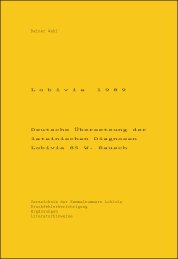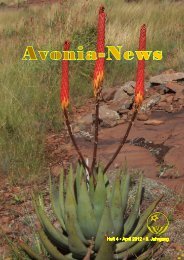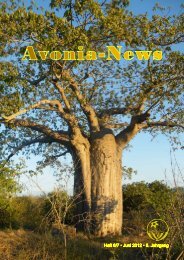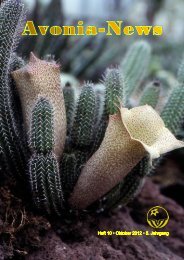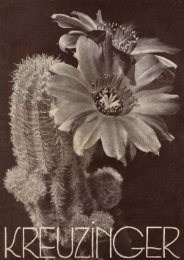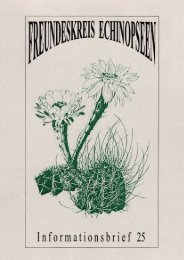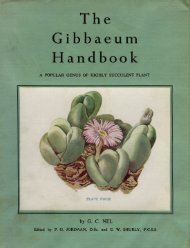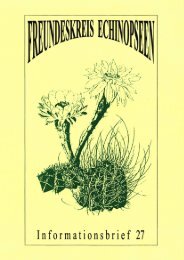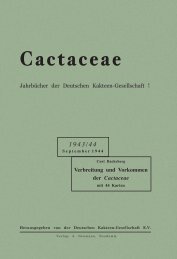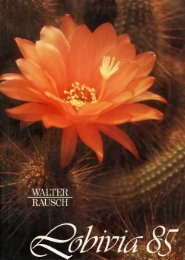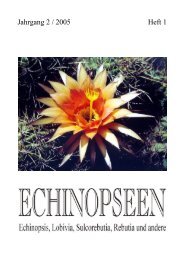Lithops - Au Cactus Francophone
Lithops - Au Cactus Francophone
Lithops - Au Cactus Francophone
You also want an ePaper? Increase the reach of your titles
YUMPU automatically turns print PDFs into web optimized ePapers that Google loves.
which he named Mesembryanthemum turbiniforme, as follows; Planta acaulis,<br />
obconica, superne truncate obscuro punctata. The plant was subsequently re<br />
named <strong>Lithops</strong> turbiniformis by N. E. Brown. This discovery was made by<br />
Burchell on September 14th, 1811, at Zand Vlei, in the Prieska district (Fig.<br />
1). More than a hundred years elapsed before this plant was rediscovered by<br />
Pole Evans in more or less the same locality as that in which it was found<br />
by Burchell. The next species to be described was named Mesembryanthemum<br />
pseudotruncatellum by Berger in 1908. This plant was found in Damaraland,<br />
Great Namaqualand, and as we now know, in the vicinity of Windhoek. In<br />
1912 Mr. Leslie discovered near Vereeniging a plant, named by N. E. Brown<br />
Mesembryanthemum Lesliei after its discoverer. These early discoveries show<br />
that the genus has a very wide distribution, as Windhoek and Vereeniging lie<br />
far apart and they are both about 500 miles from Prieska.<br />
During the period 1920–1933, large numbers of species were discovered<br />
both in the Union of South Africa and in South West Africa.<br />
Kurt Dinter, the indefatigable collector, deserves to be mentioned, for<br />
it is largely due to his enterprise that our knowledge of this genus has been<br />
so appreciably increased. It must be borne in mind that he undertook his<br />
collecting tours by oxcart and under very arduous conditions, as the majority<br />
of the South West species occur in the most arid and uninhabited parts of<br />
that dry country. One requires a knowledge of the country to know where to<br />
look for species of <strong>Lithops</strong>, as these plants are perhaps the most difficult of<br />
all to find in the field and a fairly sharp eye and one might almost say intuition<br />
are needed to find them. In the dry condition one walks on these plants without<br />
seeing them.<br />
Each individual plant consists of more or less contiguous leaves on a<br />
short stem. The whole diameter of the plant varies from about 0.5 to 5 cm.,<br />
the latter being an extreme case, as these plants are usually about 1–2 cm.<br />
in diameter. In some plants, the two leaves are separated by a very narrow<br />
fissure and in others the lobes, at least in the old stage, stand firmly apart<br />
from one another (L. divergens, L. Comptonii, L. Helmuti).<br />
4<br />
STEM<br />
As mentioned above, each individual plant consists of two more or<br />
less contiguous leaves on a short stem, the cross section of which is circular.<br />
The length of the internode is about the same as the thickness of the leaf,<br />
and is named the insertion zone. The stem is therefore not free, but only<br />
becomes so after the succulent leaves have shrunk and perished. The remains<br />
of the old leaves are dry and papery, and they protect the young leaves in<br />
their early, stages of development.<br />
In the young stage the plant does not branch at the growing point of<br />
the stem, i.e. at the base of the fissure, but a new pair of leaves is formed



